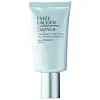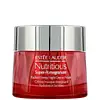Estée Lauder DayWear Multi-Protection Anti-Oxidant Sheer Tint Release Moisturizer SPF 15 Versus Estée Lauder Nutritious Super-Pomegranate Radiant Energy Night Crème/Mask
What's inside
What's inside
 Key Ingredients
Key Ingredients

 Benefits
Benefits

 Concerns
Concerns

 Ingredients Side-by-side
Ingredients Side-by-side

Ethylhexyl Methoxycinnamate 7.5%
UV AbsorberEthylhexyl Salicylate 5%
UV AbsorberButyl Methoxydibenzoylmethane 2%
UV AbsorberWater
Skin ConditioningDimethicone
EmollientCaprylic/Capric/Myristic/Stearic Triglyceride
EmollientButylene Glycol
HumectantCyclopentasiloxane
EmollientCetyl Ricinoleate
EmollientSteareth-2
EmulsifyingDi-C12-15 Alkyl Fumarate
EmollientPolysilicone-11
Pentylene Glycol
Skin ConditioningSteareth-21
CleansingAspalathus Linearis Leaf Extract
Skin ConditioningCamellia Sinensis Leaf Extract
AntimicrobialCoffea Arabica Seed Extract
MaskingPolygonum Cuspidatum Root Extract
AntioxidantTriticum Vulgare Germ Extract
Skin ConditioningBetula Alba Bark Extract
MaskingLaminaria Ochroleuca Extract
Skin ConditioningHordeum Vulgare Extract
EmollientSaccharomyces Lysate Extract
HumectantRosmarinus Officinalis Extract
AntimicrobialVitis Vinifera Seed Extract
AntimicrobialEthylbisiminomethylguaiacol Manganese Chloride
AntioxidantCholesterol
EmollientPhospholipids
Skin ConditioningMaltodextrin
AbsorbentAscorbyl Tocopheryl Maleate
AntioxidantCyclodextrin
AbsorbentSodium Hyaluronate
HumectantHydrogenated Lecithin
EmulsifyingTrehalose
HumectantNordihydroguaiaretic Acid
AntioxidantPalmitoyl Hydroxypropyltrimonium Amylopectin/Glycerin Crosspolymer
Skin ConditioningPantethine
EmollientLinolenic Acid
CleansingOryzanol
Skin ConditioningLecithin
EmollientSqualane
EmollientLinoleic Acid
CleansingGlycerin
HumectantSodium PCA
HumectantUrea
BufferingCaprylic/Capric Triglyceride
MaskingPolyethylene
AbrasiveIsopropyl Myristate
EmollientBehenyl Alcohol
EmollientSodium Carbomer
Emulsion StabilisingTromethamine
BufferingStearyl Alcohol
EmollientPvp
Emulsion StabilisingPolymethyl Methacrylate
Polyquaternium-51
Skin ConditioningCarbomer
Emulsion StabilisingParfum
MaskingDisodium EDTA
Sorbic Acid
PreservativePotassium Sorbate
PreservativeSodium Dehydroacetate
PreservativeChlorphenesin
AntimicrobialPhenoxyethanol
PreservativeLinalool
PerfumingButylphenyl Methylpropional
PerfumingHydroxyisohexyl 3-Cyclohexene Carboxaldehyde
MaskingBenzyl Salicylate
PerfumingCI 77891
Cosmetic ColorantIron Oxides
Ethylhexyl Methoxycinnamate 7.5%, Ethylhexyl Salicylate 5%, Butyl Methoxydibenzoylmethane 2%, Water, Dimethicone, Caprylic/Capric/Myristic/Stearic Triglyceride, Butylene Glycol, Cyclopentasiloxane, Cetyl Ricinoleate, Steareth-2, Di-C12-15 Alkyl Fumarate, Polysilicone-11, Pentylene Glycol, Steareth-21, Aspalathus Linearis Leaf Extract, Camellia Sinensis Leaf Extract, Coffea Arabica Seed Extract, Polygonum Cuspidatum Root Extract, Triticum Vulgare Germ Extract, Betula Alba Bark Extract, Laminaria Ochroleuca Extract, Hordeum Vulgare Extract, Saccharomyces Lysate Extract, Rosmarinus Officinalis Extract, Vitis Vinifera Seed Extract, Ethylbisiminomethylguaiacol Manganese Chloride, Cholesterol, Phospholipids, Maltodextrin, Ascorbyl Tocopheryl Maleate, Cyclodextrin, Sodium Hyaluronate, Hydrogenated Lecithin, Trehalose, Nordihydroguaiaretic Acid, Palmitoyl Hydroxypropyltrimonium Amylopectin/Glycerin Crosspolymer, Pantethine, Linolenic Acid, Oryzanol, Lecithin, Squalane, Linoleic Acid, Glycerin, Sodium PCA, Urea, Caprylic/Capric Triglyceride, Polyethylene, Isopropyl Myristate, Behenyl Alcohol, Sodium Carbomer, Tromethamine, Stearyl Alcohol, Pvp, Polymethyl Methacrylate, Polyquaternium-51, Carbomer, Parfum, Disodium EDTA, Sorbic Acid, Potassium Sorbate, Sodium Dehydroacetate, Chlorphenesin, Phenoxyethanol, Linalool, Butylphenyl Methylpropional, Hydroxyisohexyl 3-Cyclohexene Carboxaldehyde, Benzyl Salicylate, CI 77891, Iron Oxides
Water
Skin ConditioningDimethicone
EmollientIsohexadecane
EmollientGlycerin
HumectantBis-PEG-18 Methyl Ether Dimethyl Silane
EmollientButylene Glycol
HumectantPEG-10 Dimethicone
Skin ConditioningPropanediol
SolventPetrolatum
EmollientDisteardimonium Hectorite
StabilisingSucrose
HumectantHypnea Musciformis Extract
Skin ProtectingVaccinium Angustifolium Fruit Extract
Skin ProtectingPaeonia Suffruticosa Root Extract
Skin ProtectingSapindus Mukorossi Fruit Extract
Skin ConditioningCladosiphon Okamuranus Extract
Skin ConditioningCucumis Sativus Fruit Extract
EmollientHordeum Vulgare Extract
EmollientVaccinium Macrocarpon Fruit Extract
AstringentLycium Chinense Fruit Extract
AntioxidantGelidiella Acerosa Extract
Skin ProtectingGlycine Soja Seed Extract
Skin ConditioningIsododecane
EmollientAcetyl Glucosamine
Skin ConditioningSorbitol
HumectantTocopheryl Acetate
AntioxidantPunica Granatum Extract
AstringentCaffeine
Skin ConditioningErgothioneine
AntioxidantYeast Extract
Skin ConditioningPropylene Glycol Dicaprate
EmollientSodium Hyaluronate
HumectantHelianthus Annuus Seedcake
AbrasivePolysilicone-11
Caesalpinia Spinosa Gum
Skin ConditioningCaprylyl Glycol
EmollientPropylene Carbonate
SolventPolyethylene
AbrasiveTetrahexyldecyl Ascorbate
AntioxidantDextrin
AbsorbentCitric Acid
BufferingPEG-32
HumectantPEG-6
HumectantParfum
MaskingHexylene Glycol
EmulsifyingSodium Citrate
BufferingDisodium EDTA
BHT
AntioxidantCitral
PerfumingPhenoxyethanol
PreservativeIron Oxides
Water, Dimethicone, Isohexadecane, Glycerin, Bis-PEG-18 Methyl Ether Dimethyl Silane, Butylene Glycol, PEG-10 Dimethicone, Propanediol, Petrolatum, Disteardimonium Hectorite, Sucrose, Hypnea Musciformis Extract, Vaccinium Angustifolium Fruit Extract, Paeonia Suffruticosa Root Extract, Sapindus Mukorossi Fruit Extract, Cladosiphon Okamuranus Extract, Cucumis Sativus Fruit Extract, Hordeum Vulgare Extract, Vaccinium Macrocarpon Fruit Extract, Lycium Chinense Fruit Extract, Gelidiella Acerosa Extract, Glycine Soja Seed Extract, Isododecane, Acetyl Glucosamine, Sorbitol, Tocopheryl Acetate, Punica Granatum Extract, Caffeine, Ergothioneine, Yeast Extract, Propylene Glycol Dicaprate, Sodium Hyaluronate, Helianthus Annuus Seedcake, Polysilicone-11, Caesalpinia Spinosa Gum, Caprylyl Glycol, Propylene Carbonate, Polyethylene, Tetrahexyldecyl Ascorbate, Dextrin, Citric Acid, PEG-32, PEG-6, Parfum, Hexylene Glycol, Sodium Citrate, Disodium EDTA, BHT, Citral, Phenoxyethanol, Iron Oxides
Ingredients Explained
These ingredients are found in both products.
Ingredients higher up in an ingredient list are typically present in a larger amount.
Butylene Glycol (or BG) is used within cosmetic products for a few different reasons:
Overall, Butylene Glycol is a safe and well-rounded ingredient that works well with other ingredients.
Though this ingredient works well with most skin types, some people with sensitive skin may experience a reaction such as allergic rashes, closed comedones, or itchiness.
Learn more about Butylene GlycolDimethicone is a type of synthetic silicone created from natural materials such as quartz.
What it does:
Dimethicone comes in different viscosities:
Depending on the viscosity, dimethicone has different properties.
Ingredients lists don't always show which type is used, so we recommend reaching out to the brand if you have questions about the viscosity.
This ingredient is unlikely to cause irritation because it does not get absorbed into skin. However, people with silicone allergies should be careful about using this ingredient.
Note: Dimethicone may contribute to pilling. This is because it is not oil or water soluble, so pilling may occur when layered with products. When mixed with heavy oils in a formula, the outcome is also quite greasy.
Learn more about DimethiconeDisodium EDTA plays a role in making products more stable by aiding other preservatives.
It is a chelating agent, meaning it neutralizes metal ions that may be found in a product.
Disodium EDTA is a salt of edetic acid and is found to be safe in cosmetic ingredients.
Learn more about Disodium EDTAGlycerin is already naturally found in your skin. It helps moisturize and protect your skin.
A study from 2016 found glycerin to be more effective as a humectant than AHAs and hyaluronic acid.
As a humectant, it helps the skin stay hydrated by pulling moisture to your skin. The low molecular weight of glycerin allows it to pull moisture into the deeper layers of your skin.
Hydrated skin improves your skin barrier; Your skin barrier helps protect against irritants and bacteria.
Glycerin has also been found to have antimicrobial and antiviral properties. Due to these properties, glycerin is often used in wound and burn treatments.
In cosmetics, glycerin is usually derived from plants such as soybean or palm. However, it can also be sourced from animals, such as tallow or animal fat.
This ingredient is organic, colorless, odorless, and non-toxic.
Glycerin is the name for this ingredient in American English. British English uses Glycerol/Glycerine.
Learn more about GlycerinWe don't have a description for Hordeum Vulgare Extract yet.
Parfum is a catch-all term for an ingredient or more that is used to give a scent to products.
Also called "fragrance", this ingredient can be a blend of hundreds of chemicals or plant oils. This means every product with "fragrance" or "parfum" in the ingredients list is a different mixture.
For instance, Habanolide is a proprietary trade name for a specific aroma chemical. When used as a fragrance ingredient in cosmetics, most aroma chemicals fall under the broad labeling category of “FRAGRANCE” or “PARFUM” according to EU and US regulations.
The term 'parfum' or 'fragrance' is not regulated in many countries. In many cases, it is up to the brand to define this term.
For instance, many brands choose to label themselves as "fragrance-free" because they are not using synthetic fragrances. However, their products may still contain ingredients such as essential oils that are considered a fragrance by INCI standards.
One example is Calendula flower extract. Calendula is an essential oil that still imparts a scent or 'fragrance'.
Depending on the blend, the ingredients in the mixture can cause allergies and sensitivities on the skin. Some ingredients that are known EU allergens include linalool and citronellol.
Parfum can also be used to mask or cover an unpleasant scent.
The bottom line is: not all fragrances/parfum/ingredients are created equally. If you are worried about fragrances, we recommend taking a closer look at an ingredient. And of course, we always recommend speaking with a professional.
Learn more about ParfumPhenoxyethanol is a preservative that has germicide, antimicrobial, and aromatic properties. Studies show that phenoxyethanol can prevent microbial growth. By itself, it has a scent that is similar to that of a rose.
It's often used in formulations along with Caprylyl Glycol to preserve the shelf life of products.
Polyethylene is a synthetic ingredient that helps the skin retain moisture. It is a polymer.
It is also typically used within product formulations to help bind solid ingredients together and thicken oil-based ingredients. When added to balms and emulsions, it helps increase the melting point temperature.
Polysilicone-11 is a film-forming silicone that creates a non-tacky and matte finish on the skin. It's commonly used to improve texture, absorb excess oil, and help active ingredients spread evenly.
Due to its "rubber-like" structure, it stays on the skin's surface instead of being absorbed. On the skin, it creates a flexible layer that enhances wearability and stability.
Sodium Hyaluronate is hyaluronic acid's salt form. It is commonly derived from the sodium salt of hyaluronic acid.
Like hyaluronic acid, it is great at holding water and acts as a humectant. This makes it a great skin hydrating ingredient.
Sodium Hyaluronate is naturally occurring in our bodies and is mostly found in eye fluid and joints.
These are some other common types of Hyaluronic Acid:
Learn more about Sodium HyaluronateWater. It's the most common cosmetic ingredient of all. You'll usually see it at the top of ingredient lists, meaning that it makes up the largest part of the product.
So why is it so popular? Water most often acts as a solvent - this means that it helps dissolve other ingredients into the formulation.
You'll also recognize water as that liquid we all need to stay alive. If you see this, drink a glass of water. Stay hydrated!
Learn more about WaterThis ingredient is a combination of red, black, and yellow iron oxide pigments. This combination of colors is usually found in foundation, because it results in a "skin" color.